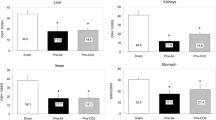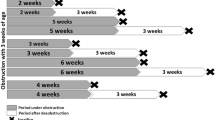Abstract
Background
Disturbed liver function tests are associated with the pneumoperitoneum applied for biliary and non-biliary laparoscopic surgical procedures. The extent, duration and reversibility of such an injury are unknown. An isolated organ model was used to assess reversibility of liver injury in a CO2–pneumoperitoneum-like environment.
Methods
Rat livers (n = 63) were isolated and perfused within a chamber pressurized at 0, 3, 5, 8, 12, 15 or 18 mmHg for 60 minutes. Pressure was annulled during the ensuing 61–90 minutes in one-half of the groups and markers of liver function were measured and recorded.
Results
Inflow pressure level, flow rate, effluent partial O2 and CO2 pressures, O2 extraction rate, lactate dehydrogenase level, lactic to pyruvic acid ratio, and total xanthine oxidase and dehydrogenase levels became abnormal, starting at 15 minutes after a pressure >5 mmHg was applied in the chamber. Signs of injury slowly reversed towards baseline values in all groups except for the 15 mmHg and 18 mmHg-pressurized ones, even after pressure had been annulled for 30 minutes.
Conclusions
CO2-pneumoperitoneum-like conditions directly injured rat liver tissue to a degree which correlated with the amount of applied pressure. Damage caused by pressure ≥15 mmHg was no longer reversible if it had been applied over a 60-minute period.





Similar content being viewed by others
References
Andrei VE, Schein M, Margolis M, Rucinski JC, Wise L (1998) Liver enzymes are commonly elevated following laparoscopic cholecystectomy: is elevated intra-abdominal pressure the cause? Dig Surg 15:256–259
Baqi N, Stock J, Lombardo SA, Geffner S, Roberti I (2006) Impact of laparoscopic donor nephrectomy on allograft function in pediatric renal transplant recipients: a single-center report. Pediatr Transplant 10:354–357
Bendet N, Morozov V, Lavi R, Panski M, Halevy A, Scapa E (1999) Does laparoscopic cholecystectomy influence peri-sinusoidal cell activity? Hepatogastroenterology 46:1603–1606
Clary EM, Bruch SM, Lau CL, Ali A, Chekan EG, Garcia-Oria MJ, Eubanks S (2002) Effects of pneumoperitoneum on hemodynamic and systemic immunologic responses to peritonitis in pigs. J Surg Res 108:32–38
Giraudo G, Brachet Contul R, Caccetta M, Morino M (2001) Gasless laparoscopy could avoid alterations in hepatic function. Surg Endosc 15:741–746
Gisek LG, Gobet RM, Peters CA (1998) Pneumoperitoneum produces reversible renal dysfunction in animals with normal and chronically reduced renal function. J Endourol 12:95–100
Gutt CN, Schmandra TC (1999) Portal venous flow during CO2 pneumoperitoneum in the rat. Surg Endosc 13:902–905
Halevy A, Gold-Deutch R, Negri M, Lin G, Shlamkovich N, Evans S, Cotariu D, Scapa E, Bahar M, Sackier JM (1994) Are elevated liver enzymes and bilirubin levels significant after laparoscopic cholecystectomy in the absence of bile duct injury? Ann Surg 219:362–36413
Hashimoto S (1974) A new spectrophotometric assay method of xanthine oxidase in crude tissue homogenate. Anal Biochem 62:426–435
Ho HS, Saunders CJ, Gunther RA, Wolfe BM (1995) Effector of hemodynamics during laparoscopy: CO2 absorption or intraabdominal pressure? J Surg Res 59:497–503
Jakimowicz J, Stultiens G, Smulders F (1998) Laparoscopic insufflation of the abdomen reduces portal venous flow. Surg Endosc 12:129–132
Kim ZG, Sanli E, Brinkmann L, Lorenz M, Gutt CN (2002) Impact of dopamine and endothelin-1 antagonism on portal venous blood flow during laparoscopic surgery. Surg Endosc 16:1292–1296
Kotake Y, Takeda J, Matsumoto M, Tagawa M, Kikuchi H (2001) Subclinical hepatic dysfunction in laparoscopic cholecystectomy and laparoscopic colectomy. Br J Anaesth 87:774–777
Morino M, Giraudo G, Festa V (1998) Alterations in hepatic function during laparoscopic surgery. An experimental clinical study. Surg Endosc 12:968–972
Nakache R, Rudick V, Fiodorov D, Klausner JM, Almogy N, Karckevski E, Weinbroum AA (1999) Cumulative damaging effect of liver hypoperfusion and cyclosporine a on the peribiliary capillary plexus: a study in an isolated dually perfused rat model. Transplantation 68:1651–1660
Richter S, Olinger A, Hildebrandt U, Menger MD, Vollmar B (2001) Loss of physiologic hepatic blood flow control (“hepatic arterial buffer response”) during CO2-pneumoperitoneum in the rat. Anesth Analg 93:872–877
Sato K, Kawamura T, Wakusawa R (2000) Hepatic blood flow and function in elderly patients undergoing laparoscopic cholecystectomy. Anesth Analg 90:1198–1202
Schmandra TC, Kim ZG, Gutt CN (2001) Effect of insufflation gas and intraabdominal pressure on portal venous flow during pneumoperitoneum in the rat. Surg Endosc 15:405–408
Tunon MJ, Gonzalez P, Jorquera F, Llorente A, Gonzalo-Orden M, Gonzalez-Gallego J (1999) Liver blood flow changes during laparoscopic surgery in pigs. A study of hepatic indocyanine green removal. Surg Endosc 13:668–672
Waldschmidt J, Haring R, Hauck W, Perez Rde P, Tung LC (1970) Experimental studies on the effect of diaphragm movement and intra-abdominal pressure on liver circulation. Thoraxchir Vask Chir 18:114–121
Weinbroum A, Nielsen VG, Tan S, Gelman S, Matalon S, Skinner KA, Bradley E Jr., Parks DA (1995) Liver ischemia-reperfusion increases pulmonary permeability in rat: role of circulating xanthine oxidase. Am J Physiol 268:G988–G996
Weinbroum AA, Hochhauser E, Rudick V, Kluger Y, Karchevsky E, Graf E, Vidne BA (1999) Multiple organ dysfunction following remote circulatory arrest: common pathway of radical oxygen species? J Trauma 47:691–698
Weinbroum AA, Kluger Y, Abraham RB, Shapira I, Karchevski E, Rudick V (2001) Lung preconditioning with N-acetyl-L-cysteine prevents reperfusion injury after liver no flow-reflow: a dose-response study. Transplantation 71:300–306
Yokoyama Y, Beckman JS, Beckman TK, Wheat JK, Cash TG, Freeman BA, Parks DA (1990) Circulating xanthine oxidase: potential mediator of ischemic injury. Am J Physiol 258:G564–G570
Acknowledgments
Esther Eshkol is thanked for editorial assistance.
Author information
Authors and Affiliations
Corresponding author
Rights and permissions
About this article
Cite this article
Szold, A., Weinbroum, A.A. Carbon dioxide pneumoperitoneum-related liver injury is pressure dependent: A study in an isolated-perfused organ model. Surg Endosc 22, 365–371 (2008). https://doi.org/10.1007/s00464-007-9411-9
Received:
Revised:
Accepted:
Published:
Issue Date:
DOI: https://doi.org/10.1007/s00464-007-9411-9




